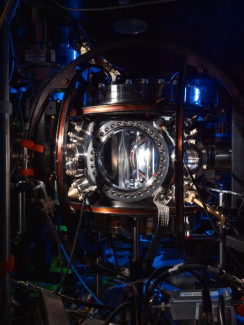JILA and NIST Fellows Jun Ye and Eric Cornell's recent research on advancing electron electric dipole moment (eEDM) measurements have been highlighted in Physics World.
These measurements, which look at the most minute distortions in the electron's shape, could be the key to helping physicists find new particles beyond those described in the Standard Model of physics. “We are able to determine the eEDM by measuring the frequency difference of this wobble, once with the electron oriented in one direction and again with it in the other,” explains Trevor Wright in the Physics World article.
The article further explains that: "After 620 hours of data collection, during which the researchers changed multiple experimental parameters to investigate and reduce systematic errors, they reduced the upper limit on the electron EDM to 4.1×10-30 e cm. This is 37 times smaller than their own previous measurement and 2.4 times smaller than the previous best limit."
Read the full article here.



 The Physics Frontiers Centers (PFC) program supports university-based centers and institutes where the collective efforts of a larger group of individuals can enable transformational advances in the most promising research areas. The program is designed to foster major breakthroughs at the intellectual frontiers of physics by providing needed resources such as combinations of talents, skills, disciplines, and/or specialized infrastructure, not usually available to individual investigators or small groups, in an environment in which the collective efforts of the larger group can be shown to be seminal to promoting significant progress in the science and the education of students. PFCs also include creative, substantive activities aimed at enhancing education, broadening participation of traditionally underrepresented groups, and outreach to the scientific community and general public.
The Physics Frontiers Centers (PFC) program supports university-based centers and institutes where the collective efforts of a larger group of individuals can enable transformational advances in the most promising research areas. The program is designed to foster major breakthroughs at the intellectual frontiers of physics by providing needed resources such as combinations of talents, skills, disciplines, and/or specialized infrastructure, not usually available to individual investigators or small groups, in an environment in which the collective efforts of the larger group can be shown to be seminal to promoting significant progress in the science and the education of students. PFCs also include creative, substantive activities aimed at enhancing education, broadening participation of traditionally underrepresented groups, and outreach to the scientific community and general public.